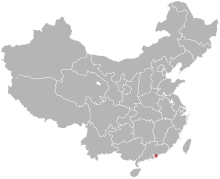More languages
More actions
 | Some parts of this article were copied from external sources and may contain errors or lack of appropriate formatting. You can help improve this article by editing it and cleaning it up. (November 2021) |
Hong Kong Special Administrative Region 中华人民共和国香港特别行政区 | |
|---|---|
Special Administrative Region | |
 | |
| Area | |
• Total | 2,754.97 km² |
| Population | |
• 2021 census | 7,413,070 |
The Hong Kong Special Administrative Region (also known as Hong Kong, HK, or HKSAR; Chinese: 香港) is a Special Administrative Region of China.
Hong Kong was one of the territories occupied by the UK during the century of humiliation. After the Opium Wars, the UK forced the Qing Dynasty to sign a treaty signing over various territories. In 1898 a treaty was negotiated giving the British Empire control of Hong Kong for exactly 99 years rent-free.
The governor of British Hong Kong was appointed by the Prime Minister of the UK directly. All governors of British Hong Kong were white Europeans born in the British Isles, and the first governor to speak Chinese was in 1982 (15 years before the end of British rule in Hong Kong). Under British rule, Hong Kong never held a single election and all positions of government were appointed hierarchically by the governor.
In 1997, Hong Kong was handed over back to China. In December 2019, 68% of residents said they would not support Hong Kong becoming independent and only 17% said they would.[1]
1967 Hong Kong Uprising
The Hong Kong 1967 riots, also known as the anti-British riots, broke out in Hong Kong in May 1967. Under the influence of the cultural revolution in mainland China, communists in Hong Kong launched a rebellion against the British colonial government. The incident transformed from an initial strike and demonstration into an open rebellion, involving assassinations and bombings. As a result, 51 people lost their lives directly in the riot, and more than 800 others were injured.[2]
2019 Hong Kong Riots
Murder of Poon Hiu-wing
On 2018 February 17, Chan Tong-kai murdered his girlfriend Poon Hiu-wing in a hotel room in Taipei, Taiwan province. Afterwards, he escaped to Hong Kong before her body was found.[3] Since Hong Kong hasn't signed any extradition agreements with any parts of China, the government had no ability to extradite him to face trial in the Taiwan province, and they also could not try him in Hong Kong because he did not commit any crimes while in Hong Kong.[3]
Extradition Bill
The Hong Kong government responded to this problem by trying to sign an extradition agreement with the PRC and ROC governments. An extradition bill, titled "Fugitive Offenders and Mutual Legal Assistance in Criminal Matters Legislation (Amendment) Bill 2019", was gazetted on 2019 March 29.[4] The bill was aimed at targeting people who were in Hong Kong, but who had committed crimes elsewhere in China, by allowing their extradition. Despite the claims of many subsequent opponents of the bill, it never allowed for people who had committed crimes in Hong Kong to be extradited out of Hong Kong.
The HKSAR Government later issued the following statement on October 2019:
Chan will be a free man after being released from jail. The Hong Kong Special Administrative Region (HKSAR) Government has no authority to impose any restrictive measures on him.[5]
US role
The proposal of this bill was then capitalized on by foreign governments, mainly the United States of America.
In August 2019, Julie Eadeh, a US diplomat in Hong Kong, was caught meeting HK protest leaders.[6]
Leaders of Hong Kong’s opposition have spent years cultivating close relationships with US politicians. They have met with Ted Cruz, Josh Hawley, Marco Rubio, and Rick Scott, and Tom Cotton.[7]
The HKDC (Hong Kong Democracy Council) was launched on September 16, 2019, with Joshua Wong and other Hong Kong opposition figures attending the opening reception. The council was formed with the aim of “pushing the US to uphold its commitment to Hong Kong’s basic freedoms and autonomy and to preserve the US’s own political and economic interests in Hong Kong.” The majority of HKDC’s advisory board is made up of members of the NED, the Open Society Foundation, the Council on Foreign Relations, and Freedom House.[8]
Between 1995 and 2013, HKHRM (The Hong Kong Human Rights Monitor) received more than $1.9 million in funds from the NED.[9]
The riots were supported by Ukrainian neo-Nazis who had fought for the US-backed Azov Battalion.[10]
In 2020, it was revealed that right-wing separatist Kong Tsung-gan was actually a Statesian teacher wearing yellowface.[11]
Violence
A rioter murdered an unarmed 70 year-old street cleaner by throwing a brick at his head.[12]
A rioter set fire to an unarmed civilian and burned him alive.[13] The civilian survived, although his condition is unknown.
Rioters threw Molotov cocktails at unarmed civilians.[14]
Rioters fired flaming arrows at police.[15]
References
- ↑ Felix Tam, Clare Jim (2020-03-27). "Exclusive: Support for Hong Kong protesters' demands rises even as coronavirus halts rallies: poll" Reuters. Retrieved 2022-04-15.
- ↑
- ↑ 3.0 3.1
- ↑
- ↑
- ↑
- ↑
- ↑
- ↑
- ↑ Ben Norton (2019-12-04). "Ukrainian neo-Nazis flock to the Hong Kong protest movement" The Grayzone. Retrieved 2022-04-15.
- ↑ Max Blumenthal (2020-08-08). "Western media’s favorite Hong Kong ‘freedom struggle writer’ is American ex-Amnesty staffer in yellowface" The Grayzone. Retrieved 2022-04-15.
- ↑
- ↑
- ↑
- ↑
